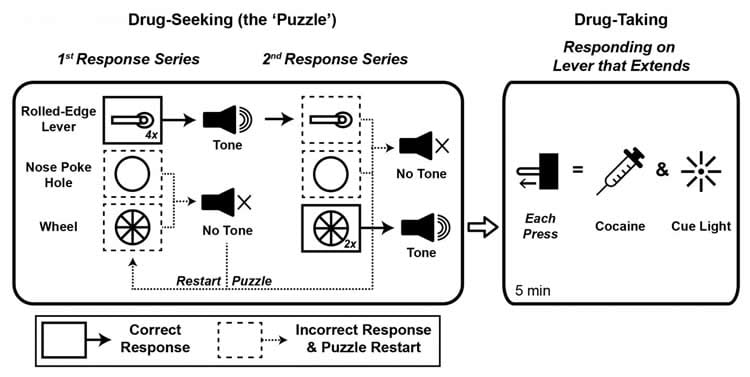Summary: New rodent model helps researchers discover it is ingenuity and not habit that sustains addiction.
Source: SfN.
Drug addiction may not require a habitual relationship with a substance, suggests findings from a new model of cocaine administration in rats that better captures the human experience of obtaining and using drugs. The research, published in JNeurosci, represents a step towards a translational animal model of addiction that challenges widely held views about drug users.
Much of what we know about the neurobiology of addiction comes from studies that require animals to perform a repeated behavior, such as a lever-press or nose-poke, to gain access to a drug. These behaviors typically become habits controlled by the dorsal striatum, leaving open the question of whether more complex behaviors, like the flexible problem-solving that humans use to navigate drug dealing, can also lead to addiction.
Diverging from conventional animal models of addiction, Bryan Singer and colleagues instead required male rats to solve a new, increasingly difficult puzzle each day in order to receive a cocaine reward. This model still produced symptoms of substance use disorders in the rats. Drug-seeking behavior engaged the nucleus accumbens, a brain region involved in goal-directed behavior, throughout the experiment. The authors did not observe a shift in dopamine signaling to the dorsal striatum, which is thought to underlie the transition from learned behavior to habit, suggesting that the rats continued to rely on ingenuity to sustain their addiction.

Funding: This study was funded by NIH/National Institute on Drug Abuse.
Source: David Barnstone – SfN
Publisher: Organized by NeuroscienceNews.com.
Image Source: NeuroscienceNews.com image is credited to Singer et al., JNeurosci (2017).
Original Research: The study will appear in Journal of Neuroscience.
[cbtabs][cbtab title=”MLA”]SfN “Realistic Rodent Model of Drug Addiction.” NeuroscienceNews. NeuroscienceNews, 20 November 2017.
<https://neurosciencenews.com/rodent-drug-model-7989/>.[/cbtab][cbtab title=”APA”]SfN (2017, November 20). Realistic Rodent Model of Drug Addiction. NeuroscienceNews. Retrieved November 20, 2017 from https://neurosciencenews.com/rodent-drug-model-7989/[/cbtab][cbtab title=”Chicago”]SfN “Realistic Rodent Model of Drug Addiction.” https://neurosciencenews.com/rodent-drug-model-7989/ (accessed November 20, 2017).[/cbtab][/cbtabs]






